Cling Film
What is Cling Film?
Cling film, also known as plastic wrap or food wrap, is a thin, flexible, and transparent plastic material used primarily for sealing and preserving food. made in polyethylene (PE), which offer high stretchability and adhesion properties.
The use of PVC Cling Film is prohibited by law in Sri Lanka. We manufacture only PE Cling Film.
PE Cling Film (Polyethylene)
More environmentally friendly and free of plasticizers.
Less sticky but safe for food storage.
Mostly used in household applications.
Advanced Applications and Uses of Cling Film
1. Food Preservation and Storage
Prevents moisture loss and keeps food fresh for a longer period.
Reduces oxidation, and slows down spoilage.
Used in vacuum sealing to improve food shelf life.
2. Microwave and Cooking Uses
Cling film is microwave-safe for covering dishes. (Depending on thickness)
3. Industrial and Commercial Applications
Used in food packaging industries for wrapping meat, vegetables, and dairy products.
Used in the medical and pharmaceutical industries to safely wrap pharmaceutical stocks.
5. Household and Miscellaneous Uses
Protects furniture and furnishings during painting.
Used to cover and wrap delicate objects for storage or transportation.
Acts as a temporary screen protector for equipment.
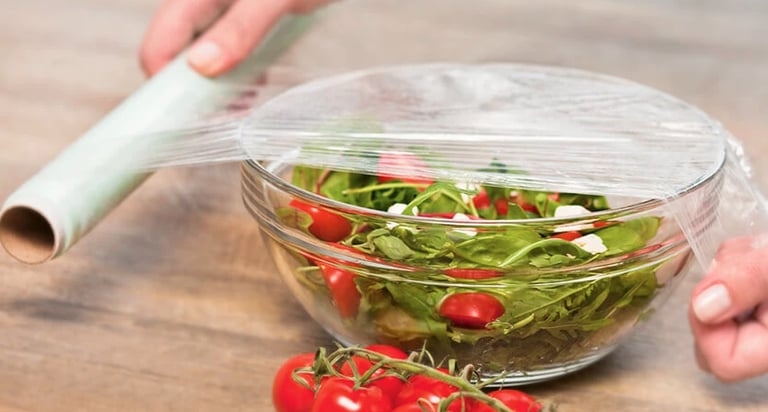

Cling Film: Standard Specifications and Properties
Is a thin, flexible, and transparent plastic material primarily used for food preservation. It is available in different formulations, mainly Polyethylene (PE)
Food Safety Compliance
EU Standard (Regulation EC 1935/2004) – Food contact safety compliance.
FDA (US Food & Drug Administration) – Approval for direct food contact.
BPA & Plasticizer-Free Options – Ensures non-toxicity, especially for microwave use.
Common Material Types Polyethylene (PE - LDPE or LLDPE) – Safer for food contact, less clingy, and more Eco-friendly.
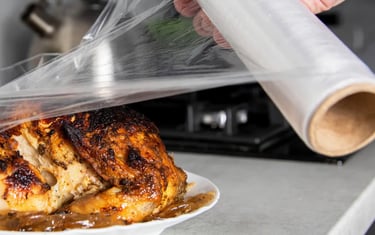

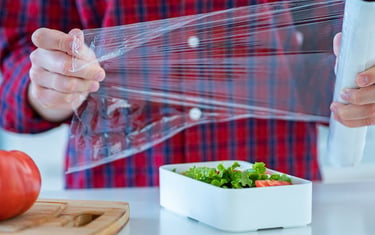

Properties of Cling Film
Elasticity and stretchability - Cling film is very stretchable, allowing it to be tightly wrapped around objects and containers.
Adhesion (stickiness) - It sticks to itself and smooths surfaces due to its static charge or low adhesion, creating a secure seal.
Transparency - It is usually clear, making it easy to see the contents of the wrapped food or container.
Waterproof - It is moisture resistant, helping to keep food fresh by preventing drying out or absorbing external moisture.
Barrier properties - It provides a barrier against air and odors, which helps preserve food and prevent cross-contamination.
Lightweight - Cling film is very thin and lightweight, making it easy to use and store.
Flexible and malleable - It easily conforms to a variety of shapes, making it ideal for wrapping irregularly shaped items.
Heat sensitivity - Some types of cling film can melt or deform when exposed to heat, while others are microwave-safe. (It's Depend on thickness)
Chemical resistance - It is resistant to most household chemicals.


Stretch & Cling Properties
Stretchability: Up to 300% elongation (varies by material type).
Cling Factor: PVC-based films have better self-adhering properties than PE-based films.
Permeability & Barrier Properties
Oxygen Transmission Rate (OTR): Allows controlled oxygen flow for fresh produce storage.
Moisture Barrier: Prevents dehydration but allows some moisture exchange to avoid condensation.
Material Composition
Made from Low-Density Polyethylene (LDPE) or Linear Low-Density Polyethylene (LLDPE).
Free from plasticizers, making it safer for direct food contact.
100% recyclable (varies by local recycling regulations).
Thickness (Gauge / Microns)
Household use: 20 microns
Commercial/industrial use: 20 microns
Width & Length
Width: 250mm to 600mm (common sizes: 300mm, 450mm, 600mm)
Length: 30m to 1000m (household: 30m–100m, industrial: 300m–1000m)
Cling Strength & Adhesion
Sticks to smooth surfaces using static charge, rather than chemical adhesion.
Temperature Resistance
Cold Resistance: Functional down to -40°C (suitable for freezing).
Heat Resistance: Up to 110°C for short periods (microwave-safe versions available).
Barrier Properties
Moisture Barrier: Prevents dehydration and maintains food freshness.
Gas Permeability: Higher oxygen and carbon dioxide permeability, which helps certain foods like fresh produce "breathe."
Odor Resistance: protection and prevents moderate odor transfer.
Stretchability & Tensile Strength
Elongation at Break: 200–400% (high flexibility).
Tensile Strength: Moderate, with resistance to tearing under normal use.
Food Safety Compliance
Approved by FDA (USA), EU 10/2011 (Europe), and other food safety standards.
Suitable for direct contact with fatty, acidic, and aqueous foods.
Environmental Impact & Recyclability
100% recyclable (LDPE / LLDPE).
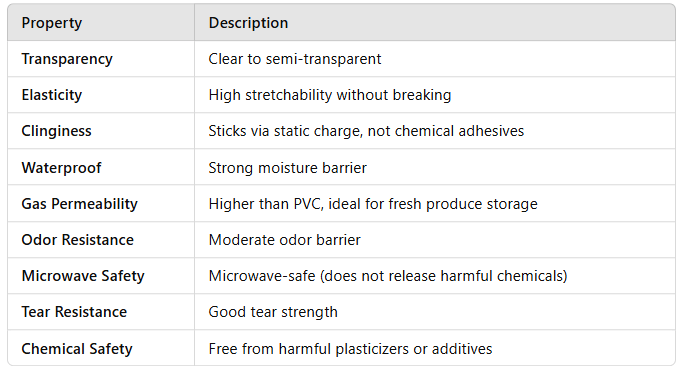

Special Features of PE (Polyethylene) Cling Film
Polyethylene (PE) cling films, especially LDPE (Low-Density Polyethylene) and LLDPE (Linear Low-Density Polyethylene), have unique properties that differentiate them from PVC or compostable wraps.
1. Food-Safe & Non-Toxic
BPA-Free & Phthalate-Free: Unlike PVC wraps, PE films do not contain harmful plasticizers, making them safer for food contact.
2. Stretchability & Strength
Flexible & Tear-Resistant: LLDPE versions offer better stretch and puncture resistance compared to regular LDPE.
Good Elastic Recovery: Helps the film stay in place after stretching.
3. Moderate Cling Ability
Electrostatic Cling: Sticks to surfaces using a mild static charge rather than chemical tackifiers.
Doesn’t Leave Residue: Unlike PVC, PE cling film doesn’t transfer plasticizers onto food or surfaces.
4. Microwave & Freezer Safe
Resistant to Freezing Temperatures: Doesn’t crack or become brittle in the freezer.
Microwave-Safe: It can be used for reheating food (but it should not directly touch hot or fatty foods).
5. Environmentally Considerate Options
Recyclable (Check Local Facilities): Some PE wraps are recyclable under the category (LDPE).
Bio-Based & Biodegradable Options: Some manufacturers are developing PE wraps with bio-based sources or additives to enhance biodegradability.
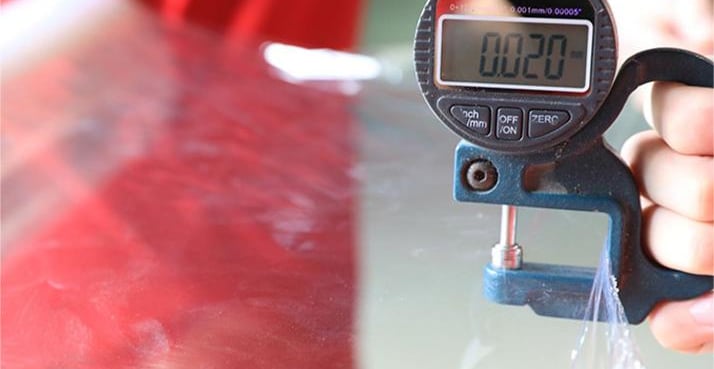

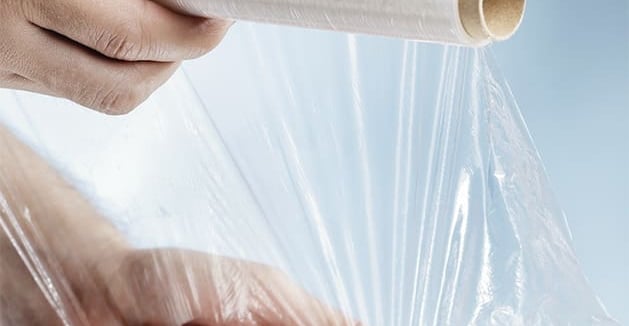

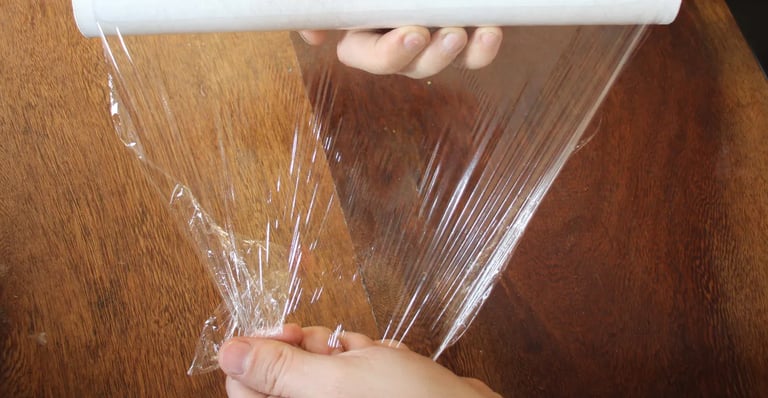

To learn more about the specifications of the product you need, please email us (info@carlton.lk) or use the WhatsApp app on this website to reach one of our sales representatives.
Key Points of Thickness
Thinner PE Films (20 µm): Used in household kitchens for wrapping food and short-term storage.
Medium Thickness (20 µm): Suitable for commercial food wrapping (e.g., restaurants, catering).
Thicker PE Films (18-30 µm): Ideal for industrial packaging, heavy-duty wrapping, and extended food storage.
Barrier Properties: Thicker films provide better resistance to tearing and punctures.
Freezer-Safe: PE cling films above 12 µm work well for frozen food storage.
The Density
Depends on the material used. Here are some common densities for different types of cling film materials:
LDPE (Low-Density Polyethylene): ~0.91–0.93 g/cm³
Why Does Density Matter?
Thinner films (lower density, like LDPE) are more flexible but may not cling as well. provide better cling and durability. behave differently based on thickness and formulation.
The Stickiness
LDPE Material Properties
LDPE (Low-Density Polyethylene): Not naturally sticky, so it relies on electrostatic charge or additives to cling.
Added Adhesives or plasticizer films (especially commercial-grade) contain plasticizers that enhance flexibility and cling.
LDPE wrap: Less sticky but still functional, used in home kitchens because it's safer than other materials.
